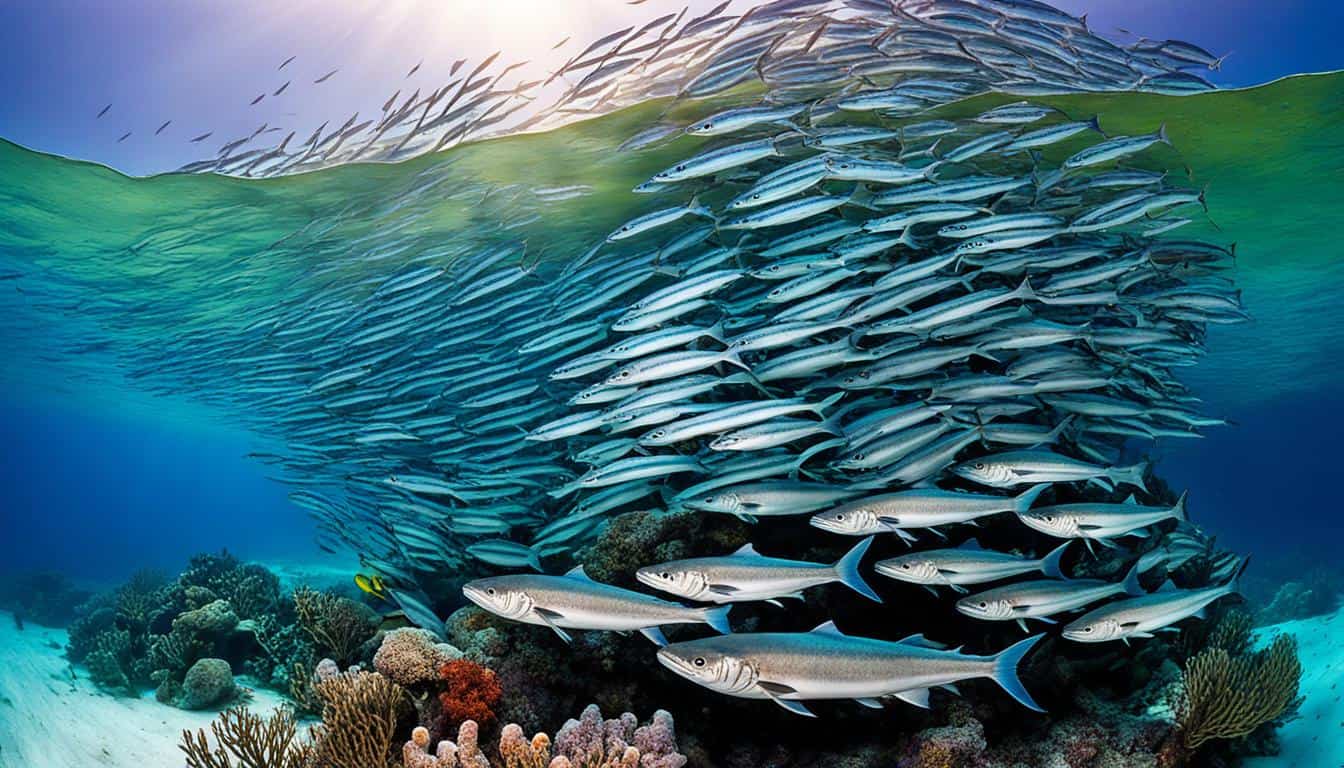Are you wondering where barracudas live? These amazing fish, especially the great barracuda, *Sphyraena barracuda*, call tropical and subtropical waters home. They live in areas between about 30° north and 30° south latitude.
In the western Atlantic, you can find barracudas from Massachusetts to Brazil. They’re common in the Gulf of Mexico and the Caribbean Sea too. They like to stay in shallow areas near the coast. You’ll find them in coral reefs, seagrass beds, and mangroves.
These places help them hunt and reproduce. They are key to their survival and growth.
Understanding Barracuda Habitat
Barracudas are fascinating fish that live in many different places. Knowing where they live helps us understand how they survive. They live in everything from shallow coastal areas to deep underwater structures. These places are key for their life and health.
Barracuda Habitat Types
Common places where barracudas live include:
- Coral Reefs: These are full of life and offer shelter and food.
- Mangroves: Young barracudas find safety here from big predators.
- Seagrass Beds: These are great for finding food.
- Open Ocean: Adults like to swim here to find the best food spots.
Barracudas are very adaptable. They can live in brackish water but prefer warm, clear water that helps them hunt. Different species live in various places, making the most of what’s available.
| Barracuda Species | Preferred Habitat Type | Common Locations |
|---|---|---|
| Great Barracuda | Coral Reefs, Open Ocean | Florida Keys, Caribbean Sea |
| Blue Barracuda | Coastal Zones | Gulf of Mexico, South Pacific |
| Spotted Barracuda | Mangroves, Seagrass Beds | Indo-Pacific Region |
Where do barracudas live?
Barracudas live in many marine environments. They can be found in both shallow and deep waters. They are very adaptable to different places. They can go as deep as 325 feet.
Barracudas are found in oceans like the Atlantic, Pacific, and Indian Oceans. They also live in the Caribbean and Red Seas. These places are perfect for their survival.
In these oceans, you can see barracudas near coral reefs or seagrass beds. These areas are great for hunting. It lets them catch their prey easily.
Knowing where barracudas live shows how important it is to keep our oceans healthy. This helps keep their numbers stable. Barracudas can live in many different places, making them interesting to learn about.
Barracuda Distribution Across Oceans
The barracuda is a fascinating species found in diverse ocean regions. They thrive in certain areas, showing their importance in marine ecosystems. Knowing where they live helps us understand their role in the ocean.
Barracuda Locations
Barracudas live mainly in warm coastal waters. You can find them in:
- The Caribbean Sea
- The Gulf of Mexico
- The Atlantic Ocean, especially near Florida and Brazil
- The eastern Atlantic, reaching the Red Sea
- Various islands in the Indo-Pacific region
Barracuda Geographic Range
Barracudas spread across many maritime areas. These places are key to their survival, offering different habitats and food. Here are some important places they call home:
- Atlantic Ocean: Along the eastern coasts of the Americas, Europe, and Africa.
- Indo-Pacific Ocean: From the Red Sea to the Pacific islands.
- Coastal Areas: In shallow waters near reefs or mangroves, perfect for hunting.

Barracuda Living Conditions
Barracudas live in warm waters, perfect for their hunting and survival. They prefer places with lots of ambush spots, like reefs and mangroves. These spots help them grow and reproduce.
Adults live in clear ocean waters full of life. Young barracudas like areas touched by freshwater, but adults stay away from brackish water. They need a stable marine home to stay healthy and live long.
Learning about barracudas helps us appreciate these amazing fish. Knowing what they need helps us protect their homes. This keeps their numbers healthy for the future.
| Aspect | Juvenile Barracuda | Adult Barracuda |
|---|---|---|
| Preferred Water Temperature | Warm waters | Warm waters |
| Habitat Type | Freshwater-influenced areas | Clear marine ecosystems |
| Ambush Hunting | Utilizes structures | Relies on diverse marine life |
| Environmental Preference | Varied, with some tolerance for brackish | Avoids brackish waters |
Importance of Barracuda Habitat for Species Survival
The survival of barracudas depends on their habitats. Places like coral reefs, mangroves, and seagrass meadows are crucial. They are not just homes for barracudas but also for many other marine species.
These areas offer food, breeding spots, and safety from predators. This helps barracudas grow strong and stable.
Coral reefs, for instance, provide shelter and hunting grounds for barracudas and other fish. Protecting these areas helps barracudas thrive in the ocean and keeps marine life diverse.
Your support for saving these habitats is key. The health of barracuda habitats affects the whole ocean ecosystem. By backing efforts to protect coral reefs, mangroves, and seagrass meadows, you help ensure barracudas and other marine life have a bright future.
FAQ
Where do barracudas typically live?
Great barracudas live in tropical and subtropical waters worldwide. They are found between 30° north and 30° south latitude. They are common along the western Atlantic coast, from Massachusetts to Brazil.
They are especially found in the Gulf of Mexico and the Caribbean Sea.
What are the main types of habitats for barracudas?
Barracudas live in shallow coastal waters. They like places like coral reefs, mangroves, and seagrass beds. These spots offer protection from predators and are good for finding food, especially for young barracudas.
In which oceanic regions can you find barracudas?
Barracudas live in both nearshore and offshore waters in the Atlantic, Pacific, and Indian Oceans. They are found in the Caribbean and Red Seas. They have a wide range in these marine areas.
What is the geographic range of barracudas?
Barracudas live in big areas of the Atlantic Ocean. They go from Florida to Brazil, and are common in the Caribbean and Gulf of Mexico. They also live in the eastern Atlantic and Red Sea, and in the Indo-Pacific region.
What are barracuda living conditions like?
Barracudas like warm waters with lots of places to hide for hunting. They mostly live in clear water. But, young barracudas can live in waters with a lot of fresh water. Adults usually stay away from brackish waters.
Why is barracuda habitat important for their survival?
The health of barracuda populations depends on their habitats like coral reefs, mangroves, and seagrass meadows. These places support barracudas and help with food, breeding, and protection from predators. They also help with overall ocean health by supporting many different kinds of life.







